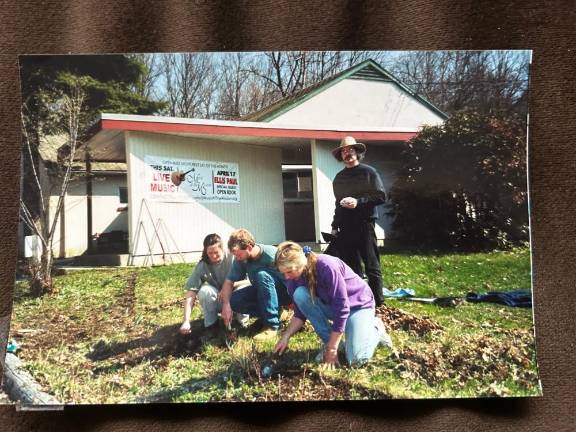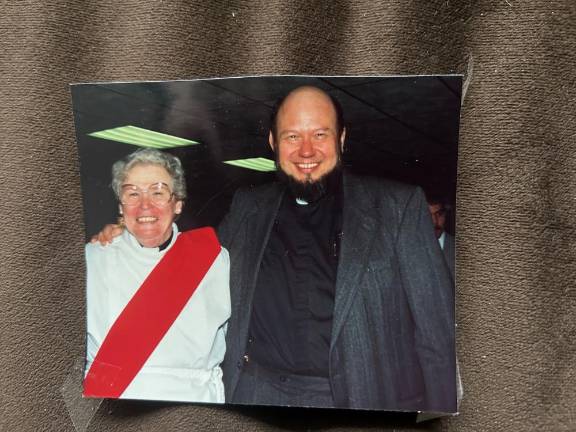

The Holy Institution Panagia Soumela Greek Orthodox Shrine Church building at 253 Marshall Hill Road originally was an Episcopal Church.
It remained so until the fall 2005, when the church closed and the property was sold to its current owners.
The story of its beginning dates to a determined woman, the late Carrie Petersen, who put her energy into the building of an Episcopal congregation and church in West Milford. She and her husband, Peter, lived in the Awosting community and were well-known throughout the township.
In May 1951, Petersen wrote a letter to Bishop Washburn of the Episcopal Diocese of Newark, asking for his support for her project. She continued to gather Episcopalians together, and on Nov. 25, 1951, the group held their first religious service in Percy Hudson’s living room. He was Petersen’s brother-in-law.
Canon Leslie and Father Chilson conducted the service and Archdeacon Jones preached.
That December, members of the newly organized congregation rented a room from Vogel’s Liquor Store in Hewitt for their church services. Vogel and the patrons of his bar apparently did not object to having a church in the same building as the bar, and they were immediately on board with financial and moral support.
The Episcopalians, apparently just happy to have a meeting place, did not seem to mind the location either.
Petersen was thrilled with the progress toward her goal to establish a local Episcopalian congregation and considered the available meeting room as “a gift from God.”
On Christmas Day 1951, Bishop Washburn came to the meeting room to officially name the congregation and the church they would build as the Church of the Incarnation, recognizing that it was the day, designated in church history, to celebrate the birth of the Christ child.
The Rev. Kenneth Whitney, the first vicar, did not stay long, leaving in early 1952. Canon Leslie and Father Andrews served for quite a few of the early years.
With Petersen continuing her crusade to have an established Episcopal congregation with a church structure, the small congregation built its first church building on property it bought on Marshall Hill Road. That building served as a church and all-purpose room from 1954 to 1967.
The Rev. James Wesdorp became the second vicar in 1955, and he remained there until 1956. Seven months with “supply clergy” followed.
Petersen and others supporting the church were not about to abandon their drive to establish a strong Episcopal congregation. They were encouraged when the Rev. Robert Jewell arrived as pastor with his wife, Helen, at his side to support his work as church organist and choir director.
Helen Jewell, a teacher, joined the faculty at Hillcrest School and assisted her husband with church duties. They lived in a rented house in the Awosting community.
Before long, a vicarage was built behind the original church building. The Jewells moved into the house during spring 1960.
Things were going well at the Church of the Incarnation, with the pastor and his wife being very much a part of the West Milford community. Both church people and others who had gotten to know the Jewells were sad when after three successful years, they left so Father Jewell could become vicar at St. Thomas Episcopal Church in Lyndhurst.
The fourth priest to settle in as church vicar was the Rev. Albert Martin. He soon became seriously ill, unable to do his work as minister, and died. Once again, there was no permanent priest for some time.
Good years for the church and its congregation came with the arrival of the Rev. Alva Decker; his wife, Mary; and their children, Albert, Elizabeth and Mary Louise. The family moved into the house on the church property.
The fifth vicar of the church, he served from February 1963 until June 1971. Father Decker’s stay of eight years was the longest of any priest until that time. Petersen was smiling a lot in those days. Her church was finally in a good place.
Father Decker reached out to help people who lived in the Ringwood Mine area, and he was instrumental in founding and serving as director of Operation Head Start to benefit children and assure their progress in school and life.
A Community Action Council, the anti-poverty agency for Passaic County funded by the Office of Economic Opportunity, grew out of this.
While Father Decker was in West Milford, a new, larger church building was constructed. Building costs were reduced because nearly all the inside work, including painting, paneling and laying floors, was done by the parishioners.
Gunther Ludwig of L & L was the general contractor, and the architect was Harold Comerro. Stanley Ricker was church warden and Robert Waitt was treasurer. The church committee members were Douglas Cherkas, Frank Cardinale, John Ricker Jr., Justin Jecker, John Martin, William Force Jr., Eugene Richards, Joseph Bender and Frank Krtausch.
The new church building was dedicated by the Right Rev. Leland Stark, Bishop of Newark, and the Right Rev. George E. Rath, Suffragan Bishop, on June 17, 1967. Father Decker participated with other clergy personnel. Helen Jewell was the organist.
During vesting of the altar, an original composition, “Uno Sforzo da Diversi” (One effort from Many) by Anthony Salvatori, a member of the congregation and professional musician, was played by a trombone quintet that included Barry Maur, Harold Shields, Fred Rasmussen, Barry Blundell and Salvatori. Acolytes were John Somerville, Bradley Bender, Walter Jordan and Michael Jewell.
The Rev. Franklin Weiler, the sixth vicar, stayed for three years until October 1974. He and his wife, Dianne, had two children, John and Diane.
After the church was without a permanent priest for nine months, the Rev. Peter Van Ness became vicar, followed by Rev. John Habecker and co-priests the Rev. John Stone and his wife, the Rev. Mary Stone.
Father John told the congregation in 1992 that financial pressures did not leave room to continue with a full-time priest. He resigned.
A priest for 28 years, Father Stone never had a sabbatical. He enrolled in the graduate school of the General Seminary in New York for the following year, studying ascetical theology (theology of prayer) as a major. The couple planned to live in a seminary apartment, and Mary Stone expected to find work in the area.
The Rev. Page Bigalow and the Rev. Reinfeld Karda were the last priests to serve as pastors at the Church of the Incarnation. Without a manse available, they traveled to West Milford to conduct the services.
Church attendance declined and the church no longer was sustainable. The Newark Diocese closed the church, and the property was sold to the Greek Orthodox group.